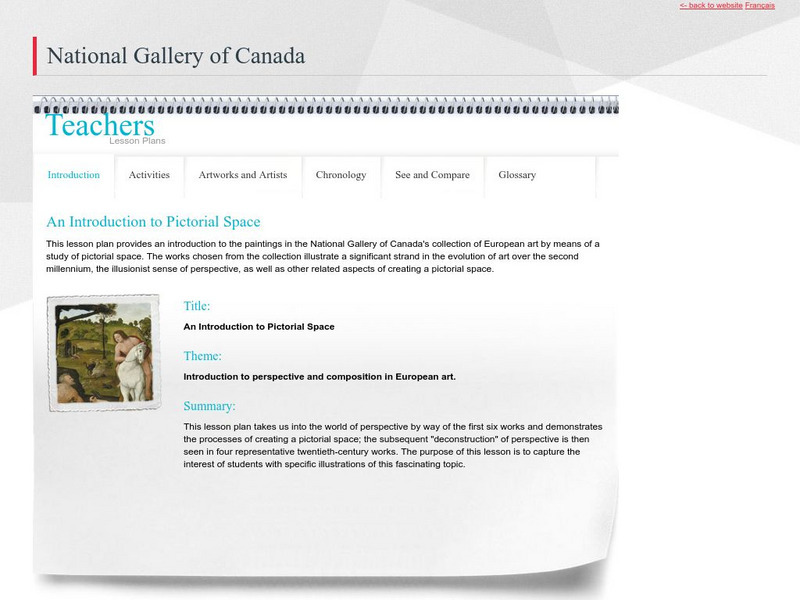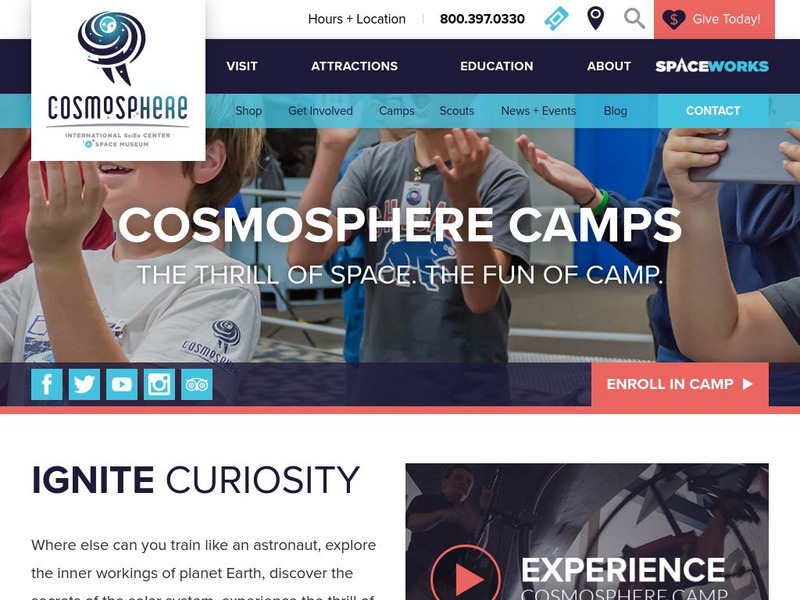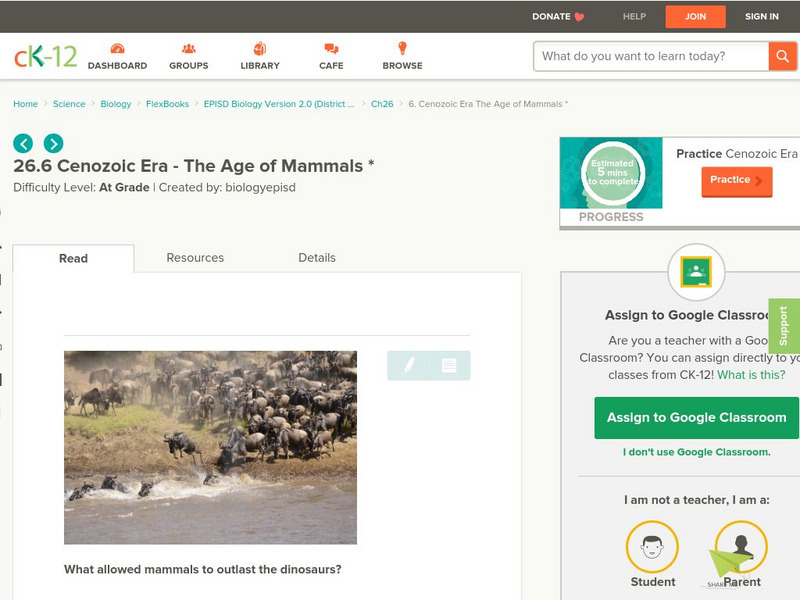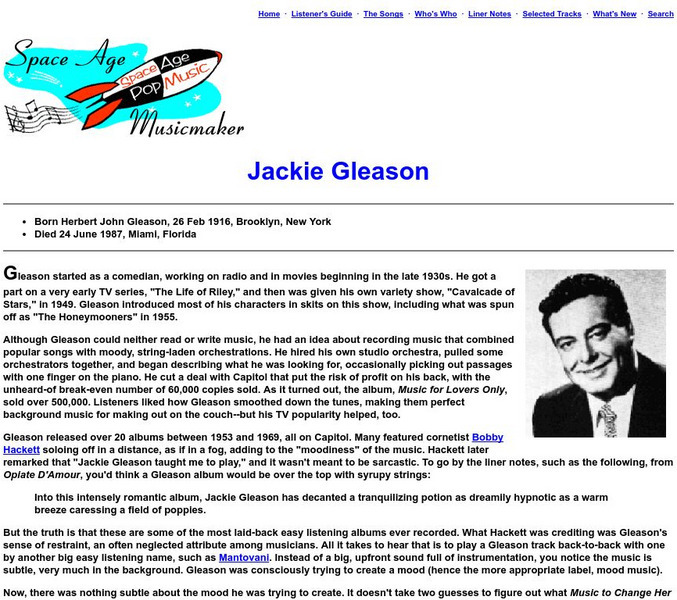Orpheus Books
Q Files: Technology: Space Transport
The story of space exploration is told from the first successful rocket built in 1926 to space probes and the International Space Station.
Library of Congress
Loc: America's Story: Johnson's Task, Unify Space Program
Russia was ahead in the "space race" in 1961. In this article, the Library of Congress discusses how President Kennedy assigned Lyndon Johnson the task of uniting the different parts of the U.S. space program into NASA.
National Gallery of Canada
Cybermuse: Introduction to Pictorial Space
A site featuring the work of Cezanne, Monet, Picasso, and Mondrian, among others, that explores pictorial space in a composition There are lesson plans for ages 4-18, and a great section where works are juxtaposed for comparison. Use the...
Discovery Education
Discovery Education: Space Age Living: Building the Iss
Discover what the International Space Station is, what it does, who is building it, where it is and the answers to many more ISS questions.
PBS
Pbs Learning Media: Space: Bringing the Universe to the Classroom: Collection
Learn to identify and predict daily patterns of motion of the Sun, Moon, and stars across the sky with various media, including an interactive storyboard featuring the beloved characters from PEEP and the Big Wide World. For a printable...
Other
Kansas Cosmosphere and Space Center: Space Camps
Check out several astronaut space programs designed for future astronauts or just curious, young scientists of all ages. See camp video, check calendar schedules, and read about the simulators at the camp site.
Smithsonian Institution
National Air and Space Museum: Exploring the Planets: Early Discovery
This section of the exhibition gives the history of the discovery and study of space starting with the Greeks and Romans through to the early 1900's.
CK-12 Foundation
Ck 12: Episd: Cenozoic Era the Age of Mammals
[Free Registration/Login may be required to access all resource tools.] The two periods of the Cenozoic Era, Tertiary and Quaternary, granted the mammals the time and space to evolve since the dinosaurs became extinct.
Smithsonian Institution
National Air and Space Museum: Wright Brothers: Embracing the Impossible [Pdf]
In this lesson plan, students explore primary resources to see what people who lived in the early age of flight felt about this innovation. They then compare that response to that towards an invention of today.
National High Magnetic Field Laboratory
Magnet Academy: Timeline of Electricity and Magnetism: 1960 1979
Computers evolve into PCs, researchers discover one new subatomic particle after another and the space age gives our psyches and science a new context.
Other
Space Age Music Maker: Jackie Gleason
This site provides a short biography on Jackie Gleason, comedian and television star.
NASA
Nasa: Space Place: How Old Is the Sun?
This cartoon helps students understand the age of our Sun, and how scientists have come to this conclusion.
Exploratorium
Exploratorium: Your Age on Other Worlds
Enter your birthday and find out how old you are on the other planets in the Milky Way Galaxy. Understand why our age is different on each planet.
American Academy of Achievement
Academy of Achievement: Admiral Alan B. Shepard, Jr., Usn
Biography of Alan Shepard, who was the first American in space and a pioneer of the space age.
NASA
Nasa History in Brief
Learn about the history of the National Aeronautics and Space Administration (NASA) and the programs it started.
Smithsonian Institution
National Air and Space Museum: Wright Brothers: Invention of the Aerial Age
Biographical details about the Ohio-born Wright brothers, who ushered in the aerial age with their invention of the first powered airplane.
Georgia Department of Education
Ga Virtual Learning: Old Age Sticks [Pdf]
The complete poem "old age sticks" by E. E. Cummings along with space to write a revised version of the poem.
PBS
Pbs Kids: Activities and Videos: Space/transportation
Find hands-on challenges that focus on the space transportation that use simple materials, allow for multiple solutions, and are ideal for ages 9-12.
NASA
Nasa: The Space Place: How Old Do I Look?
Find out how the Galex space telescope is determining the age of galaxies using red-shifted light. View pictures taken by Galex. This site also has a game which involves determining the ages of objects.
NASA
Nasa: Students K 4
NASA-sponsored coverage and research on a range of topics related to space exploration -- flying weather stations, comets, first steps on the Moon, and other space-related topics -- are presented in age-appropriate activities, lesson...
CNN
Cnn: Space Age Inventions You Probably Use (2007)
Some common items that help save lives every day or make lives a little easier are compliments of NASA technologies. This article features ten of these developments
Smithsonian Institution
National Air and Space Museum: Wright Brothers: The Invention of the Aerial Age
Beautiful, well-done site from the Smithsonian on the Wright Brothers: Who were they and what was the importance of the era they ushered in? Their roots are traced back to the Great Migration. Classroom activities and interactive...
Smithsonian Institution
National Air and Space Museum: America by Air:the Jet Age, 1958 Today
Learn about the changes that have occurred in commercial jet travel since 1958, when jet passenger service began in the United States.
Smithsonian Institution
National Museum of American History: Teaching Math & Science in Age of Sputnik
Why did the Soviet Union's launch of Sputnik throw the fields of mathematics and science into tremendous demand in the United States? Find the many ways this revolutionary event impacted children from the 1950s to become the...





















